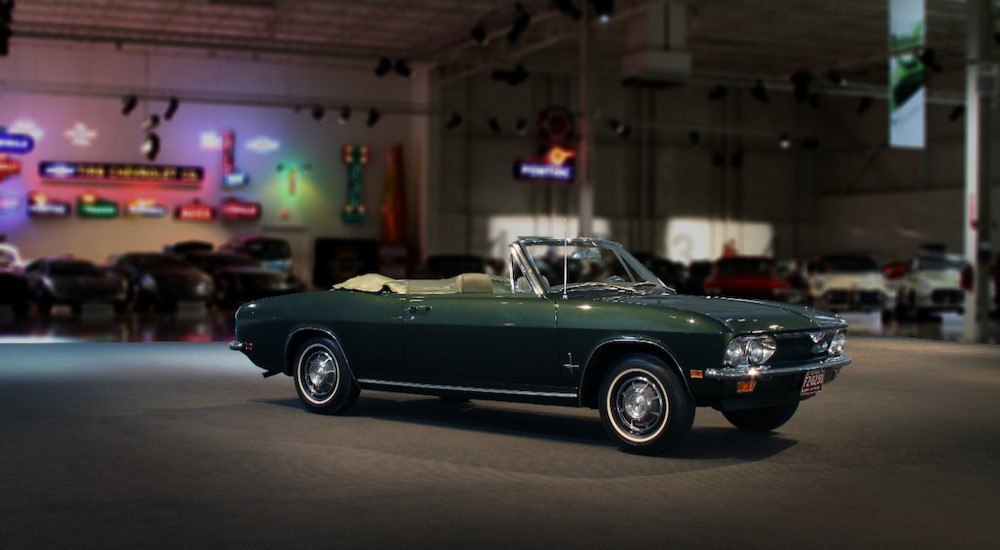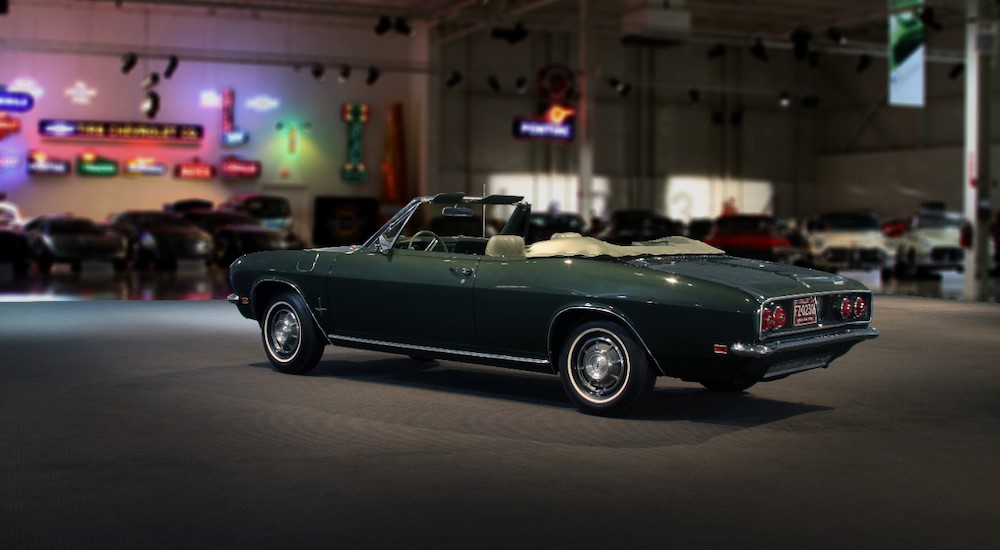Ralph Nader wore plenty of hats during his long career. The political activist, author, environmentalist, consumer advocate, and attorney is most well-known for his four failed presidential bids between 1996 and 2008, but among certain Detroit-based auto executives, he’ll go down in history as the man who killed the Chevrolet Corvair.
Released in 1960, Chevy’s early compact was supposed to meet the need for a new, smaller car that could better compete with the popular imports of the day. Instead, the Corvair lasted just nine years before ending up on the scrap heap of automotive history. Nader’s 1965 book “Unsafe At Any Speed” played a major role in this model’s demise, with chilling, first-hand accounts of the Corvair’s handling-related issues dooming the car after just five years on the market.
Subsequent studies have called Nader’s findings into question, but the controversy still raises the question: was the Chevy Corvair one of the worst cars ever made? We’ve detailed a number of notable automotive flops as part of this series, from the fiery Ford Pinto and poorly marketed Geo Prizm to the much-maligned Yugo, so how does the Corvair compare? Read on as we explore this compact’s controversial past and see how, in trying to set the stage for the future, Chevy might have irrevocably altered the modern American auto industry…
A Breath of Fresh Air
In the late 1950s, the entry-level cars rolling out of America’s three major automakers—General Motors, Ford, and Chrysler—were bigger than ever. But while these large, bulky models were popular amongst drivers, the pendulum eventually started to swing back in the other direction.
The Nash Rambler was the first model to perfect the new compact formula, and it was soon joined at the top of the sales charts by equally diminutive imports from Volkswagen, Fiat, Renault, and the like. The Big Three eventually caught on to the trend, rolling out a new generation of compacts that were basically scaled-down versions of their existing offerings. They shrunk their models by around 20%, replaced V8s with six-cylinders, and the American-made compact was born.
This approach might have satisfied an increasingly compact-hungry consumer base, but it wasn’t exactly a revolution. In designing its own compact model, Chevy took a decidedly different approach, starting with the engine. The Corvair was conceived as the American take on the Volkswagen Beetle: an economical, compact model with an air-cooled, rear-mounted engine. (The “air” in “Corvair” was used to designate the model’s air-cooled design, much like the full-size Bel Air.)
A rear-engine design offered a number of advantages over the traditional formula, allowing the Corvair to set itself apart in the increasingly competitive compact segment. The first-gen Corvair was a great deal more versatile than its German counterpart, with Chevy offering a variety of takes on this formula; these ranged from the standard four-door sedan and two-door coupe to the Lakewood four-door station wagon, the Corvan passenger van, a commercial van, a convertible, and the Rampside pickup truck.
With a rear-mounted engine, the Corvair boasted improved ride quality and traction while eliminating the need for power-assisted brakes or steering. It also made way for a lower silhouette and flatter passenger compartment floor, which went a long way in maximizing room in this smaller-than-average car.
But the rear-mounted, air-cooled engine wasn’t the only thing that set the Corvair apart, as this model was designed with a four-wheel independent suspension, monocoque body, and wide tires, and it maximized the use of weight-saving aluminum. The Corvair was also a standout from a design perspective, lacking many of the old-school ’50s flourishes like fins and chromed-out details that defined many of the most popular models of its era.
The Corvair was nothing short of a sensation when it first hit the market. This compact quickly filled its trophy case, with Chevy General Manager Ed Cole appearing alongside the Corvair on the cover of Time magazine. Cole already had a solid track record when it came to automotive design; as an engineer, before he ascended to the boardroom, he had been involved in some of Chevy’s most successful projects, like the Corvette and the small-block Chevy V8. Motor Trend named the Corvair its “Car of the Year” in 1960, and designer William L. Mitchell earned an “Industrial Designers Institute” award for his work on the model.
“Unsafe at Any Speed”
The Corvair had everything going for it, having pioneered an entirely original take on the compact and earning plenty of recognition from the auto industry and the general public alike—so what went wrong? Well, it all came down to the car’s rear-engine swing axle design…
While this approach had worked well for the Beetle, the lack of universal joints and some other peculiarities meant that the rear tires experienced an abrupt change in camber angle (how much the bottom of the tire angles in or out toward the vehicle) when cornering at higher speeds. This design flaw caused the tires to briefly lose contact with the road, resulting in a lack of traction and an abundance of oversteer. The issue was exacerbated by the fact that the rear-mounted engine put additional weight on the back wheels, resulting in a dangerous combination that saw many Corvair drivers lose control of their vehicles.
If that all sounds a little technical, it basically boils down to this: the Corvair simply didn’t have a good enough suspension to support its rear-mounted engine, resulting in a car that lost control when cornering and, in the worst-case scenario, even flipped over.
This issue might not have been so prevalent if not for the fact that American drivers were unaccustomed to vehicles with rear-mounted engines and weren’t able to adapt to the different driving style that this setup required. The problem could have been efficiently addressed if drivers were to alter their tire pressure regime to pump the rear tires up while leaving the front tires relatively low, but this quirk wasn’t effectively communicated to Corvair customers and was generally just seen as kind of a hassle.
Chevy recognized the handling issue soon after the Corvair’s release and jumped into action to redesign the 1962 model with front anti-roll bars as an optional add-on. This feature became standard in 1964, with Chevy also taking another pass at the rear suspension with new transverse-mounted leaf springs. By 1965, the compact was treated to an entirely new, fully independent rear suspension based on the Corvette, and the Corvair’s handling problems were essentially solved.
Chevy rolled out the second-gen Corvair for the 1965 model year, and this compact’s sketchy history might have been completely swept under the rug if not for that pesky Ralph Nader. The consumer protection activist studied over a hundred pending Corvair-related lawsuits and compiled his findings into a 1965 book, “Unsafe at Any Speed.”
The book was a damning account of Chevy’s design failures, and it included a particularly tragic account of a suspension engineer who had tried to warn Chevy’s management about the need for a front anti-roll bar. The book inspired a Congressional hearing where Nader nominated the Corvair for the “un-safest-car title,” and the little compact never managed to outrun its reputation. Corvair sales were halved within the year, with Chevy selling just over 100,000 models in 1966 and producing just 14,800 by 1968.
The Corvair’s failure would inspire Congress to pass the National Traffic and Motor Vehicle Safety Act in 1966, but was this car actually that bad?
A subsequent study performed by the Texas A&M University Safety Commission for the National Highway Traffic Safety Administration (NHTSA) actually found that the Corvair’s problems, while significant, weren’t actually that unique. Other rear-engine models like the Beetle and Renault Dauphine were found to perform similarly, but the problem also extended to traditional, front-engine compacts like the Ford Falcon and Plymouth Valiant. The US Department of Transportation would echo these findings in 1972, but at that point, the Corvair had already been off the market for two years.
The Auto-Buyers’ Avenger
While we’ve had a little fun maligning the Corvair, it’s only fair to put the compact’s killer under the same scrutiny. Nader was certainly better at being a thorn in the auto industry’s side than he was at running for the nation’s highest office.
Running for President under the banner of the Green Party—and later, the Reform Party and as an independent—Nader never managed to snag more than 2.7% of the vote, managing a paltry 0.4% in his 2004 bid. That said, he also never flipped over at high speeds or single-handedly stifled innovation in the American auto industry for some thirty-odd years, so Nader still makes out a little better than the Corvair.
Given his role in taking down the Corvair and his criticism of the US auto industry in general, it’s of little surprise to learn that this environmental activist doesn’t actually own a car and is an outspoken critic of the internal combustion engine. Nader has continued to rail against the auto industry’s failings well past his retirement age, blogging and publishing articles on topics ranging from GM’s 2014 ignition recall to Volkswagen’s 2015 diesel emissions scandal. Issues around next-gen auto tech—especially self-driving cars—are the activist’s current cause célèbre, as he detailed in a 2015 interview with TheVerge.com.
“The lesson today is that democracy has to control technology, because technology is out of control. It doesn’t have an ethical or legal framework or standards by which it can be curtailed when it goes off the deep end and endangers people and the environment,” said Nader. These worries have already come to pass, with self-driving models continually popping up in the news for all the wrong reasons. It might be easy for some to write Nader off as a curmudgeon or late-night talk show punchline, but there’s no denying his prescience when it comes to the Corvair.
It Belongs in a Museum
Given its notorious past, the Corvair isn’t likely to make anyone’s list of the best cars ever made, but is it really one of the worst? After all, this compact is prominently featured as the star attraction of at least one museum—except that this museum is The American Museum of Tort Law. Founded by Nader in his hometown of Winsted, Connecticut, this museum is designed to showcase the long history of legal battles waged on the part of wronged consumers.
While this is a funny footnote to our story, the fact is that the Corvair has actually become a bit of a collector’s item in the decades since it ceased production. Examples of the first-gen Corvair can be found on the classic and exotic car sale search engine Classic.com for around $15k, with pristine models selling for as much as $35k. The second-gen version—which had many of the steering-related kinks worked out—is an even hotter ticket with an average sale price of $18k, and performance-minded versions like the 1966 Chevy Yenko Stinger sell for as much as $82.5k.
In the end, the Corvair’s legacy can be seen in the models that would flow out of American factories throughout the ’70s and ’80s. Chevy had taken a big swing with its air-cooled, rear-mounted compact and failed miserably; this failure, combined with the public outcry following Nader’s report, would drag the industry in a more conservative direction in the decades to follow. Taking risks was ‘out,’ sticking to the formula was ‘in,’ and it’s hard not to see the Corvair as the model that spurred this lack of automotive imagination.
In retrospect, the Corvair might have been unfairly targeted by a man who didn’t know a gas pedal from a clutch, but it’s also hard to ignore the hundred-plus lawsuits on which Nader based his book. The Corvair might not be the worst car ever made, but it does serve as a cautionary tale for any auto executives looking to cut corners or rush through safety testing.




